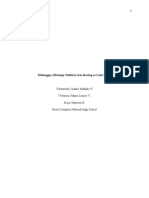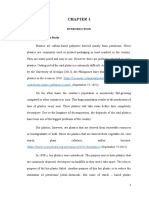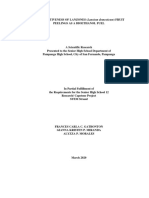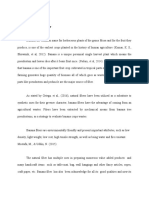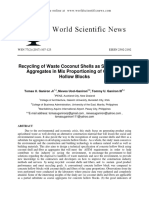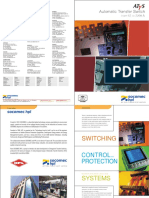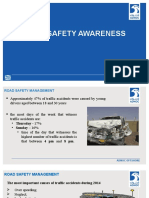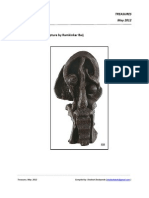Professional Documents
Culture Documents
Review of Related Literature 2.1 Review of Foreign Literature
Review of Related Literature 2.1 Review of Foreign Literature
Uploaded by
Dorothy Kate Del Mundo0 ratings0% found this document useful (0 votes)
1K views8 pagesThe document reviews literature on coconut husks, rice husks, and their various uses. Coconut husks contain cellulose, lignin and other compounds. Studies have found coconut fiber to be effective in soil engineering and slope protection due to its strength and durability. Rice husks are a byproduct of rice production and have been used to make bricks in Thailand by mixing with clay and rice husk ash. Rice husk ash has also been used as an insulator and in concrete due to its insulating properties. Both coconut husks and rice husks have been researched for their viability in construction materials due to their low cost and availability.
Original Description:
Original Title
RRL
Copyright
© © All Rights Reserved
Available Formats
DOC, PDF, TXT or read online from Scribd
Share this document
Did you find this document useful?
Is this content inappropriate?
Report this DocumentThe document reviews literature on coconut husks, rice husks, and their various uses. Coconut husks contain cellulose, lignin and other compounds. Studies have found coconut fiber to be effective in soil engineering and slope protection due to its strength and durability. Rice husks are a byproduct of rice production and have been used to make bricks in Thailand by mixing with clay and rice husk ash. Rice husk ash has also been used as an insulator and in concrete due to its insulating properties. Both coconut husks and rice husks have been researched for their viability in construction materials due to their low cost and availability.
Copyright:
© All Rights Reserved
Available Formats
Download as DOC, PDF, TXT or read online from Scribd
Download as doc, pdf, or txt
0 ratings0% found this document useful (0 votes)
1K views8 pagesReview of Related Literature 2.1 Review of Foreign Literature
Review of Related Literature 2.1 Review of Foreign Literature
Uploaded by
Dorothy Kate Del MundoThe document reviews literature on coconut husks, rice husks, and their various uses. Coconut husks contain cellulose, lignin and other compounds. Studies have found coconut fiber to be effective in soil engineering and slope protection due to its strength and durability. Rice husks are a byproduct of rice production and have been used to make bricks in Thailand by mixing with clay and rice husk ash. Rice husk ash has also been used as an insulator and in concrete due to its insulating properties. Both coconut husks and rice husks have been researched for their viability in construction materials due to their low cost and availability.
Copyright:
© All Rights Reserved
Available Formats
Download as DOC, PDF, TXT or read online from Scribd
Download as doc, pdf, or txt
You are on page 1of 8
CHAPTER 2
REVIEW OF RELATED LITERATURE
2.1 REVIEW OF FOREIGN LITERATURE
Coconuts (Cocos nucifera) are produced in 92 countries worldwide on about more than 10
million hectares. Indonesia, Philippines and India account for almost 75% of world coconut
production. The coconut fruit yields 40% coconut husks containing 30% fiber, with dust making
up the rest. The chemical composition of coconut husks consists of cellulose, lignin,
pyroligneous acid, gas, charcoal, tar, tannin, and potassium. (Salman 2 Zafar, December 2015).
The cellulose content in old coconuts is 41.7% (Fatmawati et al., 2013). However, a study
about the cellulose and lignin content of young coconuts has not yet been conducted.
Furthermore, mature coir fibres contain more lignin, a complex woody chemical, and less
cellulose than fibres such as flax or cotton (FAO, 2018). Since young coconuts have less lignin
content than old ones, the study used young coconuts, specifically, seven-month old coconuts,
also known as “poppers” as one of the components of CoCoPel.
Santha (2006) stated that coconut fiber (coir) is an efficient material in soil engineering
because of its unique features that bear the establishment of sustainable vegetation and
abundance. It also displays strength in the material and the rate of its decay is 9 slow. Out of all
available natural fibers, coir holds the most strength and durability. The effectiveness of the coir
in slope protection reaches a wide-range of things. Coir wattles as an example can be used in
various ways. They can be used as a sediment barrier in traffic places because the material’s
strength is enough to hold the weight of the construction materials and equipment without being
damaged or deformed. It is also used for construction in highways. It is also requiring less effort
after the construction because it can be left in place and will degrade naturally, therefore
lessening the expenses and effort in doing its removal, waste hauling, and waste disposal. Coir
mattresses, coir logs, coir block system, coir wattles, and woven bristle coir mats are some of the
coir products available used in slope protection. In a recent study by Dela Cruz, Famero, &
Librada (2017), they identified the coco net as nets made from coconut husks used often for
slope protection and stabilization. They also exemplify high tensile strength and its purpose is to
provide soil protection during heavy rains and for erosion, creating a blanket-like cover for the
soil. From their findings, coming from the Bureau of Research and Standards (BRS) of the
Department of Public Works and Highways (DPWH), the whole effectiveness of the coco nets
will not be achieved if it is not in the presence of vegetation because initially, coco nets are used
to stabilize the soil. They added that in the joint method of hydroseeding and coco net for slope
protection, the use of coco net aids in the vegetation of a grass in absorbing water, known as
vetiver and it is known to contribute in making the earth stabilized.
On the other hand, there are approximately 700 million tons of rice being produced around
the world (António et al., 2018). Based on the statistics that were done by the Philippine
Statistics Authority [PSA] (2018), as of 2016 there are 17.63 metric tons of rice being produced
in the Philippines, making it the most produced crop in the country. Some of the provinces that
contribute the most of this rice are from Cagayan Valley (Cagayan and Isabela).
There have been studies that are using rice husk and rice husk ash in different applications.
One of the researches used rice husks as their main component of the product that they are
building, one of which is bricks. A brick is a term that refers to a building material that is used
for construction or building material. There are places in Thailand that use rice husks to build
bricks. First, they burn it and turn them into rice husk ash. Some bricks in Thailand are made out
of clay, sawdust and rice husk ash. They conclude that the addition of rice husk ash in 2% to the
bricks affects the properties of the bricks to its strength and density. Other researchers also found
out how rice husks can be beneficial to many industrial applications. (Sutas, Mana, & Pitak,
2011). In reliance, compared to other biomass fuels, approximately 20%, rice husk has an
uncommonly high in ash. It holds mostly 90% 9 silica which has a high absorbent and light in
weight. Furthermore, it has a very high surface area. Other applications of rice husk ash include
as an insulator which has good quality of insulating properties which also involves low thermal
conductivity, a high melting point, low bulk density and high porosity. Rice husk ash can be used
as "tundish powder" (Haryati et al., 2017). Based on the research done by Mistry (2016), rice
husks are mostly used as fuel in boilers for processing paddy and generation of process steam.
Heat energy is produced through direct combustion. Small sector process industries use fixed
low capacity boilers, which are manually fired using rice husk as a fuel. Partial and uneven fuel
combustion leads to smoke emission and decrease the fuel efficiency. As husks are virtually
available for free, the boiler efficiency and the degree of combustion were the issues of receiving
the latest attention. Raw rice husks have also been used in the past to make cement-based
building materials, such as in Qin, Gao, & Chen’s (2018) study. They incorporated raw rice
husks into a cement paste and observed the product’s mechanical strength, thermal conductivity,
and other properties. As the product of their study exhibited great potential, it has been proven
that it will be possible to improve a material’s thermal insulating performance by incorporating
rice husks into the mix. The possibility of creating a thermal insulator that would be energy-
efficient and would have less environmental impact is even more attainable. Other researchers
also used rice husk in concrete mixing, and in the study made by Carig, et al (2015), one of the
useful solutions to minimize the amount of rice husk waste is to use the rice husk ash from
combustion as a mineral mixture in concretes. And as a result the problem and cost associated
are reduced, if not entirely eliminated. And because of its low cost, it comes with a great demand
for people in composing buildings and 10 infrastructures. Also, its durability and strength can
withstand tough conditions of the environment. Based on the research done by Yang, Lourenco,
& Estefen (2018), there are several works that have been done in optimizing pipe insulation for
district heating. In their study, it shows district heating energy shows the temperature that the
pipelines that has been governed by the amount of energy from fuel that has been generating the
thermal energy. In addition, there have been studies where researchers develop a structural and
thermal optimization design method for insulated flowline configuration. In accordance to their
studies and experiments, they compared the cost and relation to the insulation to the material,
and they come up with the conclusion using the linear regression is established because of the
accurate and direct pattern between the temperature and insulation thickness. Same as the study
of Meng et al., (2018), there are several studies that are performed just to evaluate the
effectiveness of using insulators to insulate and the difference that are being notice because of
the thickness and the location in reducing energy consumption in different kinds of weather
namely summer and winter by various wall orientation and based on their experiment, that
during the time that the heat is prominent, the wall and the foamed that is attached on the
concrete wall had the highest thermal response rate and having the surface with high temperature
and they conclude that among the six wall that they examined the interior insulation and concrete
wall that self-insulate are the most suitable for the heating operation that is intermittent and the
other four walls that have an insulation layer are the one of the highest response rate and the
location of the insulation to the inner surface was more suitable for intermittent heat operation.
2.2 REVIEW OF RELATED LOCAL LITERATURE
Natural fibers have been an important material in daily human life since the dawn of
civilization. They are greatly elongated substances produced by plants and animals that can be
spun into filaments, thread or rope. Natural fibers may be classified according to their source as
cellulosic (from plants), protein (from animals), and mineral. Plant fibers may be seed hairs,
such as cotton; bast fibers, such as linen; leaf, such as sisal; and husk fibers, such as coir from
the coconut. Animal fibers include wool, hair, fur, and secretions, such as silk. The only
important mineral fibers is asbestos; but due to its associated health problems, it is of
little economic consequence nowadays (Nw (2009)). Among them, plant fibers are popularly
used to reinforce composites (Akil et al (2011).
According to the report of Year of Natural Fibre (2009) [5], coconut fibre is one of the
fifteen of the world's major plant and animal fibres. The application of coconut fibre has a long
history. Coconut fibres-based products were introduced in late the 19th century, and now there is
a wide range of products made from coconut fibres. More than 25 products could be made from
coconut fibres like ropes, mattresses, brushes, geotextiles, and automobile seats and so on.
Like other natural fibres, properties of coconut fibre vary and depend mainly on its sources.
So, it is difficult to predict the properties of coconut fibres and thereafter those of cementitious
composites containing fibres. In recent years, many researchers investigated the addition of
coconut fibres to cementitious composites for various purposes. They indicated that coconut
fibre has demonstrated a series of advantages. Among all the natural fibres, coconut fibre has the
highest tearing strength and retains this property even in wet conditions [60]. Fig. 1.8 shows
typical tensile stress-strain relationships of single fibres. Coconut fibre is the most resistant and
the most ductile fibre among plant fibres
Rice husks are unique in nature and have 60-90% silica content. The silica from rice hulls,
as said in the annual worldwide output, is more than 3.2 million tons which causes
environmental issues due to its disposal concerns. Rice hull combustion resulting to a silica-rich
rice hull ash is useful for the economy and is environment-friendly. But, its usefulness has been
destabilized due to poor interaction with polymers and limited dispersion abilities. Some reasons
of poor performance are impurity, porosity, irregular topography, and chemical and
thermodynamic nature, occurring from its surface polarity, which negatively influence the
fillermatrix contacts. From a novel combustion process, the silica ash had 6% impurity, which
was around 3% volatile. It also proposes that its salination effectiveness is lower than the other
commercial silica due its porosity that could hide a part of the silane used. Processing also
changed the distribution of particle size which could have made an impact on the accumulating
tendencies and marked the reinforcing ability of the silica ash. By thermogravimetric studies,
surface silanol groups of rice hull ash estimation indicated that the density of surface silanol was
found 16/nm2 . This value is comparable to the density of silanol on precipitated silica, but there
is a high surface free energy which added to its tendencies of high amount and poor abilities of
dispersion and distribution revealed by a thermodynamic study of silica ash surface.
2.3 REVIEW OF RESEARCH RELATED LITERATURE
Coconut fibre is extracted from the outer shell of a coconut. The common name, scientific
name and plant family of coconut fibre is Coir, Cocos nucifera and Arecaceae (Palm),
respectively. There are two types of coconut fibres, brown fibre extracted from matured coconuts
and white fibres extracted from immature coconuts. Brown fibres are thick, strong and have high
abrasion resistance. White fibres are smoother and finer, but also weaker. Coconut fibres are
commercial available in three forms, namely bristle (long fibres), mattress (relatively short) and
decorticated (mixed fibres). These different types of fibres have different uses depending upon
the requirement. In engineering, brown fibres are mostly used. According to official website of
International Year for Natural Fibres 2009, approximately, 500 000 tonnes of coconut fibres are
produced annually worldwide, mainly in India and Sri Lanka. Its total value is estimated at $100
million. India and Sri Lanka are also the main exporters, followed by Thailand, Vietnam, the
Philippines and Indonesia. Around half of the coconut fibres produced is exported in the form of
raw fibre.
Yuhazri, M.Y. and Dan, M.M.P. (2007) utilized coconut fibres in the manufacturing of
motor cycle helmet. They used epoxy resins from thermo set polymer as the matrix materials and
coconut fibres as the reinforcement. After the development of helmet shells fabrication method,
mechanical testing (dynamic penetration) was performed on this composite material to determine
its performance. The result in the mechanical performance showed that coconut fibres performed
well as a suitable reinforcement to the epoxy resin matrix.
Eventually, there have been studies that are using rice husk and rice husk ash in different
applications. One of the researches used rice husks as their main component of the product that
they are building, one of which is bricks. A brick is a term that refers to a building material that
is used for construction or building material. There are places in Thailand that use rice husks to
build bricks. First, they burn it and turn them into rice husk ash. Some bricks in Thailand are
made out of clay, sawdust and rice husk ash. They conclude that the addition of rice husk ash in
2% to the bricks affects the properties of the bricks to its strength and density. Other researchers
also found out how rice husks can be beneficial to many industrial applications. (Sutas, Mana, &
Pitak, 2011). In reliance, compared to other biomass fuels, approximately 20%, rice husk has an
uncommonly high in ash. It holds mostly 90% 9 silica which has a high absorbent and light in
weight. Furthermore, it has a very high surface area. Other applications of rice husk ash include
as an insulator which has good quality of insulating properties which also involves low thermal
conductivity, a high melting point, low bulk density and high porosity. Rice husk ash can be used
as "tundish powder" (Haryati et al., 2017). Based on the research done by Mistry (2016), rice
husks are mostly used as fuel in boilers for processing paddy and generation of process steam.
Heat energy is produced through direct combustion. Small sector process industries use fixed
low capacity boilers, which are manually fired using rice husk as a fuel. Partial and uneven fuel
combustion leads to smoke emission and decrease the fuel efficiency. As husks are virtually
available for free, the boiler efficiency and the degree of combustion were the issues of receiving
the latest attention. Raw rice husks have also been used in the past to make cement-based
building materials, such as in Qin, Gao, & Chen’s (2018) study. They incorporated raw rice
husks into a cement paste and observed the product’s mechanical strength, thermal conductivity,
and other properties. As the product of their study exhibited great potential, it has been proven
that it will be possible to improve a material’s thermal insulating performance by incorporating
rice husks into the mix. The possibility of creating a thermal insulator that would be energy-
efficient and would have less environmental impact is even more attainable. Other researchers
also used rice husk in concrete mixing, and in the study made by Carig, et al (2015), one of the
useful solutions to minimize the amount of rice husk waste is to use the rice husk ash from
combustion as a mineral mixture in concretes. And as a result the problem and cost associated
are reduced, if not entirely eliminated. And because of its low cost, it comes with a great demand
for people in composing buildings and 10 infrastructures. Also, its durability and strength can
withstand tough conditions of the environment. Based on the research done by Yang, Lourenco,
& Estefen (2018), there are several works that have been done in optimizing pipe insulation for
district heating. In their study, it shows district heating energy shows the temperature that the
pipelines that has been governed by the amount of energy from fuel that has been generating the
thermal energy. In addition, there have been studies where researchers develop a structural and
thermal optimization design method for insulated flowline configuration. In accordance to their
studies and experiments, they compared the cost and relation to the insulation to the material,
and they come up with the conclusion using the linear regression is established because of the
accurate and direct pattern between the temperature and insulation thickness. Same as the study
of Meng et al., (2018), there are several studies that are performed just to evaluate the
effectiveness of using insulators to insulate and the difference that are being notice because of
the thickness and the location in reducing energy consumption in different kinds of weather
namely summer and winter by various wall orientation and based on their experiment, that
during the time that the heat is prominent, the wall and the foamed that is attached on the
concrete wall had the highest thermal response rate and having the surface with high temperature
and they conclude that among the six wall that they examined the interior insulation and concrete
wall that self-insulate are the most suitable for the heating operation that is intermittent and the
other four walls that have an insulation layer are the one of the highest response rate and the
location of the insulation to the inner surface was more suitable for intermittent heat operation.
REFERENCES
António, J., Tadeu, A., Marques, B., Almeida, J., & Pinto, V. (2018). Application of rice
husk in the development of new composite boards. Construction and Building Materials, 432-
439.
Alam, F. (2014). Properties of Coconut/Coir Fiber | Manufacturing Process of Coconut Fiber
|Application of Coconut Fiber. Retrieved August 2017, from
http://textilelearner.blogspot.com/2014/01/properties-of-coconutcoir-fiber.html Allen & Leech
(1997); Bentrup and Hoag (1998). Bioengineering Measures. Retrieved July 2017, from
http://lib.icimod.org/record/27708/files/Chapter%204%20Bioengineering.pdf
Buratti, C., Belloni, E., Lascaro, E., Merli, F., & Ricciardi, P. (2018). Rice husk panels for
building applications: Thermal, acoustic and environmental characterization and comparison
with other innovative recycled waste materials. Construction and Building Materials, 338-349.
doi:10.1016/j.conbuildmat.2018.03.089
Carig, J. G. (2015). Utilization of Rice Husk Ash (RHA) as Partial Replacement to Ordinary
Portland Cement (OPC) in Thermal Resistant Concrete Hollow Blocks (CHB). 2015
International Conference on Environmental Quality Concern, Control and Conservation.
Kaohsiung, Taiwan ROC.
You might also like
- SM-Gehl RT105 & Mustang 1050RT Compact Track Loaders Service Repair Manual 50950457Document353 pagesSM-Gehl RT105 & Mustang 1050RT Compact Track Loaders Service Repair Manual 50950457tonyNoch keine Bewertungen
- Comprehensive Nclex Notes - Easy To ReadDocument97 pagesComprehensive Nclex Notes - Easy To ReadBilal Yousuf98% (59)
- Feasibility Study of Banana Peels and Coconut Husks As An Alternative Raw Materials For Paper MakingDocument45 pagesFeasibility Study of Banana Peels and Coconut Husks As An Alternative Raw Materials For Paper MakingA - CAYAGA, Kirby, C 12 - HermonNoch keine Bewertungen
- Research Study Concrete BricksDocument33 pagesResearch Study Concrete BricksMARK JEFTE BRIONESNoch keine Bewertungen
- A Research About The Strength of Banana Leaf Fibers For Rope ProductionDocument20 pagesA Research About The Strength of Banana Leaf Fibers For Rope ProductionFrida Faye Lacsamana33% (3)
- TALISAY (Terminalia Catappa) LEAF FIBERS AS A Wood-Free Paper SubstituteDocument63 pagesTALISAY (Terminalia Catappa) LEAF FIBERS AS A Wood-Free Paper SubstituteSophie Baroman100% (1)
- The Acceptability of Rubber Tree Sap (A As An Alternative Roof SealantDocument7 pagesThe Acceptability of Rubber Tree Sap (A As An Alternative Roof SealantHannilyn Caldeo100% (2)
- Thesis RawDocument74 pagesThesis RawBryan YuNoch keine Bewertungen
- Chapter 1 3Document24 pagesChapter 1 3Ec Maranan100% (1)
- Feasibility of Abelmoschus Esculentus (Okra) As The Main Ingredient in Making A PaperDocument9 pagesFeasibility of Abelmoschus Esculentus (Okra) As The Main Ingredient in Making A PaperCandice Aberin Mag-alasinNoch keine Bewertungen
- Investigatory ProjectDocument18 pagesInvestigatory ProjectT M TNoch keine Bewertungen
- Effects of Corn Husk and Corn Cob As Raw Materials Group-4-Chapter-1-5Document60 pagesEffects of Corn Husk and Corn Cob As Raw Materials Group-4-Chapter-1-5Josethe Ann Delos SantosNoch keine Bewertungen
- Chapter 2Document8 pagesChapter 2Joaquin ValenciaNoch keine Bewertungen
- COCONUT HUSKS (Cocos Nucifera) AND ORANGE PEELS (Citrus Sinensis) FOR Production of Pinning BoardsDocument20 pagesCOCONUT HUSKS (Cocos Nucifera) AND ORANGE PEELS (Citrus Sinensis) FOR Production of Pinning BoardsAriana Nicolette GabucanNoch keine Bewertungen
- Capstone DraftDocument4 pagesCapstone Drafta jNoch keine Bewertungen
- Coconut Shell Ash and Coconut Husk Ash As Partial Replacement For CementDocument8 pagesCoconut Shell Ash and Coconut Husk Ash As Partial Replacement For CementSelena Gerasta Mujar100% (1)
- Rice Husk Particle Board Heat InsulatorFINALDocument39 pagesRice Husk Particle Board Heat InsulatorFINALRyota KagimoriNoch keine Bewertungen
- Chapter 1 - Husk and Leaf PaperDocument4 pagesChapter 1 - Husk and Leaf PaperMaria Kassandra EtcubanasNoch keine Bewertungen
- Coconut Husk As Hollow BlockDocument5 pagesCoconut Husk As Hollow BlockMark Jp Rebogio Tadeo50% (2)
- Production of Paper From Carabao GrassDocument64 pagesProduction of Paper From Carabao Grassmary balansag100% (1)
- SIP - CORK - BOARD FinalDocument21 pagesSIP - CORK - BOARD FinalLM CorveraNoch keine Bewertungen
- Final Revised Manuscript of ResearchDocument35 pagesFinal Revised Manuscript of ResearchKay Laguna100% (1)
- Malunggay (Moringa Oleifera) Tree Shaving As CorkboardDocument20 pagesMalunggay (Moringa Oleifera) Tree Shaving As CorkboardMinni Han100% (1)
- Banana Peels As Paper Final OutputDocument20 pagesBanana Peels As Paper Final OutputA - CAYAGA, Kirby, C 12 - HermonNoch keine Bewertungen
- Characterization of Carbonized Corn Cob Particles As Potenial Biosorbents On Removing of Copper From Contaminated WaterDocument15 pagesCharacterization of Carbonized Corn Cob Particles As Potenial Biosorbents On Removing of Copper From Contaminated WaterKrishiaDeVeraNoch keine Bewertungen
- The Usage of Coconut (Cocos Nucifera) Waste (Husk) As An Alternative and Sustainable Source of PaperDocument8 pagesThe Usage of Coconut (Cocos Nucifera) Waste (Husk) As An Alternative and Sustainable Source of PaperLuke kenneth MacalawaNoch keine Bewertungen
- Snake Plant ResearchDocument4 pagesSnake Plant ResearchCharles Abian100% (1)
- Potentials of Utilizing Zea Mays Corn Husk As Replacement Resources For The Production of Paper For Food Packaging 1Document55 pagesPotentials of Utilizing Zea Mays Corn Husk As Replacement Resources For The Production of Paper For Food Packaging 12023106979Noch keine Bewertungen
- Palawan State University: Republic of The PhilippinesDocument43 pagesPalawan State University: Republic of The PhilippinesFern Baldonaza0% (1)
- SIP REPORT FINALSssDocument34 pagesSIP REPORT FINALSssLeo Plaza Jr.100% (1)
- Taro Leaves (Colocasia Esculenta) As Hydrophobic Bio-Wax Coating For Recycled Grocery Paper BagsDocument11 pagesTaro Leaves (Colocasia Esculenta) As Hydrophobic Bio-Wax Coating For Recycled Grocery Paper BagsShua HongNoch keine Bewertungen
- SodaPDF Converted Chapter 1 5 of Group 5 5Document66 pagesSodaPDF Converted Chapter 1 5 of Group 5 5Drea TheanaNoch keine Bewertungen
- Chapter 1 Edited.Document22 pagesChapter 1 Edited.Christine Cabilitasan100% (1)
- Roof SealantDocument1 pageRoof SealantLarah Cagbay100% (1)
- Related Literature: "Efficiency of Mango Seed (Mangitera Indica) As An Alternative Charcoal Briquette"Document5 pagesRelated Literature: "Efficiency of Mango Seed (Mangitera Indica) As An Alternative Charcoal Briquette"Remelyn dela cruz100% (1)
- THE ACCEPTABILITY OF ORANGE (Citrus Sinensis) PEELS AS A MATERIAL FOR MAKING BIOPLASTICDocument6 pagesTHE ACCEPTABILITY OF ORANGE (Citrus Sinensis) PEELS AS A MATERIAL FOR MAKING BIOPLASTICMira Qnal100% (1)
- Compressive Strength of Waste Glass Powder and Mussel Shell Ash As Partial Replacement For CementDocument39 pagesCompressive Strength of Waste Glass Powder and Mussel Shell Ash As Partial Replacement For CementAngelica L. Tan100% (1)
- Apple Snail As Additive To ConcreteDocument11 pagesApple Snail As Additive To ConcreteJay Ar0% (1)
- Catappa) and Its Fruits Are Scattered EverywhereDocument18 pagesCatappa) and Its Fruits Are Scattered EverywhereRichelle ValienteNoch keine Bewertungen
- The Effectiveness of Lanzones Lansium Domesticum Peelings As Bioethanol FuelDocument15 pagesThe Effectiveness of Lanzones Lansium Domesticum Peelings As Bioethanol FuelGeorgia LovelaceNoch keine Bewertungen
- ScriptDocument6 pagesScriptKimlawrence JavierNoch keine Bewertungen
- Review of Related Literature and Studies 2.1 Related Readings and LiteratureDocument4 pagesReview of Related Literature and Studies 2.1 Related Readings and LiteratureArjelyNoch keine Bewertungen
- Donato-Final Research-Chapter-1-4Document23 pagesDonato-Final Research-Chapter-1-4ALEX ANTHONY ULEPNoch keine Bewertungen
- Okra Mucilage As Adhesive in Paper RecyclingDocument16 pagesOkra Mucilage As Adhesive in Paper RecyclingSaibor LynnNoch keine Bewertungen
- What Is Peanut HuskDocument5 pagesWhat Is Peanut HuskVictoria Roselle Almarez100% (1)
- Banana Paper RRLDocument2 pagesBanana Paper RRLDonita Gloria0% (1)
- Utilization of Dried Coconut Cocus Nucifera Leaves in Making CorkboardDocument26 pagesUtilization of Dried Coconut Cocus Nucifera Leaves in Making CorkboardAdrian Samonte100% (2)
- SNAKE-PLANT-RESEARCH FinalDocument6 pagesSNAKE-PLANT-RESEARCH FinalCharles Abian50% (2)
- Research Capstone SIP FinalDocument13 pagesResearch Capstone SIP FinalJatriya SphynxsNoch keine Bewertungen
- Durability of Cow Feces As PaperDocument54 pagesDurability of Cow Feces As PaperChristine Joy Dela PeñaNoch keine Bewertungen
- Taro FiberDocument4 pagesTaro FiberAlyssa Gian Carmona100% (1)
- Mga ArticleDocument22 pagesMga ArticleMar Lorenz Robles LingaoNoch keine Bewertungen
- Coconut Fiber Research PaperDocument63 pagesCoconut Fiber Research PaperChris Llamoso100% (2)
- pr2 Research Proposal - 2Document12 pagespr2 Research Proposal - 2Ma Nikki Ramirez100% (1)
- Chapter 1Document7 pagesChapter 1Triszha DeinlaNoch keine Bewertungen
- RRL Making Paper From Saba Banana PeelDocument3 pagesRRL Making Paper From Saba Banana PeelKara Isabel MatiasNoch keine Bewertungen
- FLOORWAXDocument30 pagesFLOORWAXALTHEA BORJANoch keine Bewertungen
- RRL LocalDocument4 pagesRRL Localvtuazon19Noch keine Bewertungen
- Hemp Concrete PDFDocument9 pagesHemp Concrete PDFNadeem YousafzaiNoch keine Bewertungen
- Conut Shell: A Substitute For Aggregate in Mix Proportioning of CementDocument17 pagesConut Shell: A Substitute For Aggregate in Mix Proportioning of CementStephanie SilaoNoch keine Bewertungen
- Natural Fibre Composites and Its Potential As BLDG MaterialDocument8 pagesNatural Fibre Composites and Its Potential As BLDG MaterialpincoNoch keine Bewertungen
- 2018 Science Investigatory FiberglassDocument21 pages2018 Science Investigatory FiberglassysonNoch keine Bewertungen
- Atys CatalogueDocument31 pagesAtys CatalogueepicenterrulezNoch keine Bewertungen
- Sensory Analysis of Pet FoodsDocument26 pagesSensory Analysis of Pet FoodsLaisNoch keine Bewertungen
- ND Production Engineering Assignment1 DUE DATE:29/09/2017 1)Document1 pageND Production Engineering Assignment1 DUE DATE:29/09/2017 1)Alexander MugabeNoch keine Bewertungen
- Flygt FGC Brochure 893463Document4 pagesFlygt FGC Brochure 893463Consul TechNoch keine Bewertungen
- Maria Puiu - Genetic Disorders-InTech (2013)Document352 pagesMaria Puiu - Genetic Disorders-InTech (2013)binreNoch keine Bewertungen
- Carpet Types PDFDocument8 pagesCarpet Types PDFkiranNoch keine Bewertungen
- Opertional Amplifiers ReviewDocument11 pagesOpertional Amplifiers ReviewEmre ÖzerNoch keine Bewertungen
- Chemistry-Ch 21 - Experimental Design and Separation TechniquesDocument11 pagesChemistry-Ch 21 - Experimental Design and Separation TechniquesHassan Riaz100% (1)
- Titles For Forensic Science - Allocated (1) .FinalDocument3 pagesTitles For Forensic Science - Allocated (1) .FinalTSHIRELETSO KOLAAGANONoch keine Bewertungen
- 2.4.1 Development Plan Written Statement Full DocumentDocument426 pages2.4.1 Development Plan Written Statement Full DocumentDoug WeirNoch keine Bewertungen
- SdfaDocument40 pagesSdfasandeepNoch keine Bewertungen
- Techniques For Improving Productivity: Work Study - Method StudyDocument82 pagesTechniques For Improving Productivity: Work Study - Method StudySitangshu PalNoch keine Bewertungen
- Non-Destructive Testing (NDT) - Methodology CAPO TEST (Cut & Pull Out)Document6 pagesNon-Destructive Testing (NDT) - Methodology CAPO TEST (Cut & Pull Out)Krishna UmbareNoch keine Bewertungen
- Titan PDFDocument8 pagesTitan PDFSriLakshmiNoch keine Bewertungen
- Operating Instructions For Aerzen Vacuum BoostersDocument22 pagesOperating Instructions For Aerzen Vacuum BoostersWira Tehran Services Co.100% (1)
- Hoppecke GroE BrochureDocument2 pagesHoppecke GroE BrochurecifthasekipasaNoch keine Bewertungen
- Cativa de Gor Capitulo16 TradDocument32 pagesCativa de Gor Capitulo16 TradfredlegradyNoch keine Bewertungen
- Design of Concrete Structures-IiDocument2 pagesDesign of Concrete Structures-IiAkash DeepNoch keine Bewertungen
- Project Name: North Dagon Hospitsl 10/21/2020Document2 pagesProject Name: North Dagon Hospitsl 10/21/2020codefinderNoch keine Bewertungen
- Models - Woptics.step Index Fiber BendDocument24 pagesModels - Woptics.step Index Fiber BendMoti Ben LaishNoch keine Bewertungen
- Report Project 2Document12 pagesReport Project 2Fiq IFTNoch keine Bewertungen
- Admin 4 NTCDocument7 pagesAdmin 4 NTCRabiNoch keine Bewertungen
- A Nomogram For Calculation of Aerobic Capacity (Physical Fitness) From Pulse Rate During Submaximal WorkDocument4 pagesA Nomogram For Calculation of Aerobic Capacity (Physical Fitness) From Pulse Rate During Submaximal WorkEstebanNoch keine Bewertungen
- Road Safety AwarenessDocument28 pagesRoad Safety AwarenessImran KhanNoch keine Bewertungen
- The Spontaneous Order: A Contribution To Hayek's Liberalism?Document38 pagesThe Spontaneous Order: A Contribution To Hayek's Liberalism?Craig JohnsonNoch keine Bewertungen
- The Poet: A Sculpture by Ramkinkar Baij: TreasuresDocument7 pagesThe Poet: A Sculpture by Ramkinkar Baij: TreasuresShailesh DeshpandeNoch keine Bewertungen
- DL05 User Manual PDFDocument478 pagesDL05 User Manual PDFJuvenal G. C. GallardoNoch keine Bewertungen
- Procedure: (Exp. 1) Preparation of A Standard Solution of Sulfamic AcidDocument3 pagesProcedure: (Exp. 1) Preparation of A Standard Solution of Sulfamic AcidRewanNoch keine Bewertungen






















